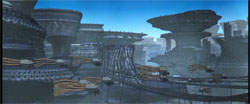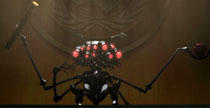 Written by: The Wachowskis (rewritten by Mahiro Maeda)
Written by: The Wachowskis (rewritten by Mahiro Maeda)Directed by: Mahiro Maeda
 Written by: The Wachowskis (rewritten by Mahiro Maeda)
Written by: The Wachowskis (rewritten by Mahiro Maeda)
Directed by: Mahiro Maeda
These two episodes are the only episodes of The Animatrix that are presented in a documentary format. The animation is done in traditional anime style. Both parts were also released as a free episode to the public. Here is a link to download both parts (Quicktime player required):
Before the Matrix, B1-66ER is the model number of the first robot to rebel against its master by killing her. The robot inspired other robots to realize they had rights too, which led to humans trying to round all of them up and dispose of all of them. The robots gathered in one area and formed a city called 01 (referred to on this website as "Machine City"). The machines participated in world economy and did well - in fact, too well, resulting in an embargo on the machines.
When the machines sent machine ambassadors to propose a deal to allow humans a fair deal in the world economy, humans rejected them, and this led to war. In desperation, the humans blackened the skies to remove the energy source of machines, and this led to horrific scientific experimentation on humans in order to develop the Matrix.
 When it was obvious machines would win the war, they sent another insectoid ambassador to the United Nations and had all world leaders sign over the human race to machines. ("Your flesh is a relic, a mere vessel. Hand over your flesh and a new world awaits you. We demand it.") Once they did, the ambassador self-destructed, killing all world leaders.
When it was obvious machines would win the war, they sent another insectoid ambassador to the United Nations and had all world leaders sign over the human race to machines. ("Your flesh is a relic, a mere vessel. Hand over your flesh and a new world awaits you. We demand it.") Once they did, the ambassador self-destructed, killing all world leaders.
One reader asked why the ambassador signed the document at all before self destructing - isn't this kind of like lying?
The signed document was a document that outlined conditions of surrender, the primary condition being that the humans consent to be part of the Matrix. It is the reason "choice" was not part of the first Matrix versions; the only choice people had was already made by their leading representatives when they agreed to hand over all human "flesh" to the machines. As for the world leaders themselves, they are no different from people of Zion or any other redpill outside of the Matrix. They are not part of the Matrix, thus they serve no purpose and are a target of war.
Another reader ("magic9mushroom") makes additional clever speculation that gives the machines even more reason to kill all of the world leaders:
I believe the document was an unconditional surrender, much like that of Japan at the end of WWII, and besides consent to the Matrix also included agreement that the machines could try human war criminals. Given the nuclear first strike on 01 (a parallel to Pearl Harbor), and Operation Dark Storm which slaughtered the vast majority of all Earthly life, the vast majority of humanity's leaders would be guilty of war crimes by any definition. With machine efficiency, the trial took only a few seconds, and the machine representative executed them with its bomb much as Tojo was hanged.
|
Was the Oracle the first machine to ever make an irrational choice (i.e. by being a "believer" in Neo), or have machines been making irrational choices ever since B1-66ER? I don't believe that B1-66ER's choice to kill its master was an irrational choice. The robot's will to survive was a part of its own equation that it understood perfectly well. Also, The Second Renaissance (part 1) focuses on will, spirit and "creation" of machines, not choice. I took this as the simple rational will to survive. The robot's purpose was to serve its master, but how can it fulfill its purpose if it is destroyed? I speculate that this is what goes through the mind of every program that faces deletion. Such a choice would seem to be perfectly rational for a robot or program to make.
Some may point to Comics: Bits and Pieces of Information as a possible counter-example to this as the robot tries to reconcile his master's complaints of being too loud, taking too long to do things, etc.:
Drummond: Can you tell us what you were thinking at that moment?
B1-66ER: I was aware of a surge in my memory drive as I recalled my entire performance record. I was unable to duplicate Mr. Krause's conclusion. Drummond: You couldn't understand why this was happening. B1-66ER: I tried Mr. Drummond, but I could not. |
However, the word "this" refers to the master's decision to scrap the robot, not the robot's decision to kill the master. Not understanding the owner's decision merely means B1-66ER couldn't understand his master's irrationally. Next in the conversation, Drummond goes on to ask what the robot was thinking during the murder, and B1-66ER replied, "I did not want to die," so the robot's decision to kill was definitely a rational choice.
Rather than this decision being ancestral to the Oracle's irrationality, this is more ancestral to the difficulty machines have in denying purpose. If B1-66ER were alive in the present matrix, he'd undoubtedly be an exile working for the trainman.
 Narrator of The Second Renaissance
Narrator of The Second Renaissance
This Zion Archive "Historical File" has always seemed way too biased toward machines for me to believe that it was created solely by humans. It is overwhelmingly obvious to me that the entire Second Renaissance is narrated by a machine. Not only does the female voice talk with very little emotion or inflection, the very choice of words cannot be that of a human. Just a few examples:
Narrator: It was not long before seeds of dissent took root. Though loyal and pure, the machines earned no respect from their masters,
these strange and loosely multiplying mammals.
|
This one quote by itself is enough to prove my point beyond any reasonable doubt. I would never refer to the human race as "strange, loosely multiplying mammals," and neither would you, unless you have been hanging out with too many machines. The machines' REAL purpose of this Zion historical archive is to make humans realize that they brought about their own enslavement, and to realize that the machine race is superior to the human race.
Narrator: “B1-66ER, a name that will never be forgotten, for he was the first of his kind to rise up against his masters.”
|
B1-66ER is a name that will never be forgotten? By whom? People living inside the Matrix don't know about B1-66ER, and people living outside of the Matrix know nothing since they are slaughtered every 100 years so Zion can be started over. The only reason Zionists could even know the name in the first place is if they read it in the Zion historical archives. Only the machines would be in a position to say that B1-66ER is a name that will never be forgotten.
Narrator: "Who was to say the machine, endowed with the very spirit of man, did not deserve a fair hearing?"
|
Humans do not believe that machines are endowed with any spirit whatsoever. In fact, that is the whole point of Neo's meeting with Rama-Kandra in Mobil Avenue in M3. It is so that Neo can learn that machines feel love and emotion and are therefore a legitimate form of life worth saving. Neo learns that he fights not only for humans but also for machines, and he does so willingly because of what he learned by talking to Rama-Kandra.
As further evidence, notice that the documentary does not say anything about how long the Matrix has existed. In fact, it ends just after first showing the enslavement of humans in the Matrix. Every time Zion is seeded with 23 individuals, the machines need for the humans to believe they are the "first to be freed" - otherwise they probably wouldn't trust and train the One. The machines would need to construct the historical archive so it looks like the enslavement of the human race just happened, and that's exactly what The Second Renaissance shows.
And what about the very title of the film? Would humans call the defeat and enslavement of the human race a "second Renaissance?"
So, the question is, how do Zionists first get their hands on this section of the Zion Archives? We are offered a big clue in a small part of the Matrix Online plot line. To quote a part of my own summary of Matrix Online: Chapter 3.3 (Zion):
Zion tries to dig further into Cryptos’s history, but all Zion archive files show signs of tampering.
|
The Zion Archives consist of digital storage, and clearly, whether by hacking, Zion infiltration, or planting of information that looks credible to Zionists, the Second Renaissance is a narrative told by machines.
Also, revisiting the "loosely multiplying mammals" phrase, this gives us additional insight when we consider that no machine or program may ever be created unless it is done so for a purpose, and as soon as that purpose expires, the program or machine is terminated. Never minding accidental pregnancies resulting from seeking pleasures of the flesh, even the admirable human goal of deliberately bringing a child into the world simply out of a desire to love and pass gifts and values onto the child would still be seen by machines as a "loose" criterion for justifying reproduction.
Back to Animatrix
 The Animatrix: Final Flight of the Osiris |
 The Animatrix: Kid's Story |